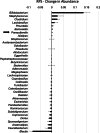Increasing levels of Parasutterella in the gut microbiome correlate with improving low-density lipoprotein levels in healthy adults consuming resistant potato starch during a randomised trial
- PMID: 33303023
- PMCID: PMC7731750
- DOI: 10.1186/s40795-020-00398-9
Increasing levels of Parasutterella in the gut microbiome correlate with improving low-density lipoprotein levels in healthy adults consuming resistant potato starch during a randomised trial
Abstract
Background: Prebiotics, defined as a substrate that is selectively utilized by host microorganisms conferring a health benefit, present a potential option to optimize gut microbiome health. Elucidating the relationship between specific intestinal bacteria, prebiotic intake, and the health of the host remains a primary microbiome research goal.
Objective: To assess the correlations between gut microbiota, serum health parameters, and prebiotic consumption in healthy adults.
Methods: We performed ad hoc exploratory analysis of changes in abundance of genera in the gut microbiome of 75 participants from a randomized, placebo-controlled clinical trial that evaluated the effects of resistant potato starch (RPS; MSPrebiotic®, N = 38) intervention versus a fully digestible placebo (N = 37) for which primary and secondary outcomes have previously been published. Pearson correlation analysis was used to identify relationships between health parameters (ie. blood glucose and lipids) and populations of gut bacteria.
Results: Abundance of Parasutterella (phylum Proteobacteria) tended to increase in the gut microbiome of individuals consuming RPS and those increases in Parasutterella were correlated with reductions in low-density lipoprotein (LDL) levels in participants consuming RPS but not placebo. Segregating RPS-consuming individuals whose LDL levels decreased (ie "Responders") from those who did not (ie. "Non-Responders") revealed that LDL Responders had significantly higher levels of Parasutterella both at baseline and after 12 weeks of consuming RPS.
Conclusion: Our analyses suggest that RPS may help improve LDL levels depending upon the levels of Parasutterella in an individual's gut microbiome.
Trial registration: This study protocol was reviewed and approved by Health Canada (Submission #188517; "Notice of Authorization" dated 06/05/13) and registered as NCT01977183 (10/11/13) listed on NIH website: ClinicalTrials.gov. Data generated in this study have been submitted to NCBI ( http://www.ncbi.nlm.nih.gov/bioproject/381931 ).
Funding: MSP Starch Products Inc.
Keywords: Cholesterol; LDL; Parasutterella; Potato; Proteobacteria; Resistant starch.
Conflict of interest statement
Jason Bush is employed by and Michelle Alfa provides consulting services for MSP Starch Products Inc., Carberry, MB, Canada, who manufacture MSPrebiotic® resistant potato starch.
Figures





References
-
- Gibson G, Hutkins R, Sanders M, Prescott S, Reimer R, Salminen S, Scott K, Stanton C, Swanson K, Cani P, Verbeke K, Reid G. Expert consensus document: the international scientific Association for Probiotics and Prebiotics (ISAPP) consensus statement on the definition and scope of prebiotics. Nat Rev Gastroenterol Hepatol. 2017;14(8):491–502. doi: 10.1038/nrgastro.2017.75. - DOI - PubMed
-
- Alfa MJ, Strang D, Tappia PS, Olson N, DeGagne P, Bray D, Murray B-L, Hiebert B. A Randomized Placebo Controlled Clinical Trial to Determine the Impact of Digestion Resistant Starch MSPrebiotic on Glucose, Insulin, and Insulin Resistance in Elderly and Mid-Age Adults. Front Med (Lausanne) 2018;4:260. doi: 10.3389/fmed.2017.00260. - DOI - PMC - PubMed
-
- Zeevi D, Korem T, Zmora N, Israeli D, Rothschild D, Weinberger A, Ben-Yacov O, Lador D, Avnit-Sagi T, Lotan-Pompan M, Suez J, Mahdi JA, Matot E, Malka G, Kosower N, Rein M, Zilberman-Schapira G, Dohnalová L, Pevsner-Fischer M, Bikovsky R, Halpern Z, Elinav E, Segal E. Personalized nutrition by prediction of glycemic responses. Cell. 2015;163(5):1079–1094. doi: 10.1016/j.cell.2015.11.001. - DOI - PubMed
Associated data
LinkOut - more resources
Full Text Sources
Medical
Research Materials
